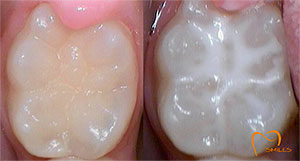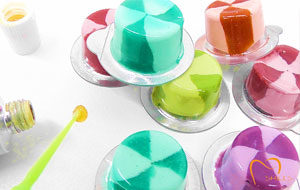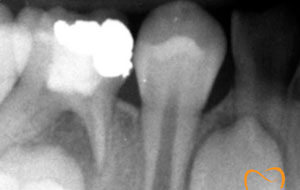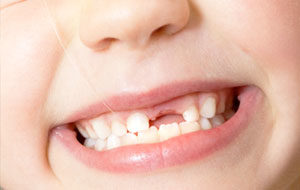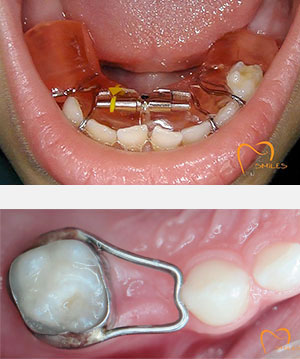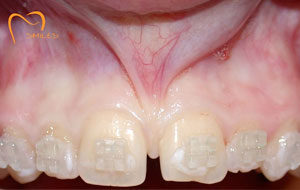FOR OUR LITTLE PATIENTS
Painless treatments for the protection of primary teeth
The dental needs of our young patients are formed according to their age.

The future behavior of children towards the health of their teeth depends a lot on how they are treated as young patients. In Smiles Dental Clinic we care a lot about the kids’ perception of their dentist, offering painless treatments in order to protect their sensitive teeth. There is a special designed space in the waiting room that can offer some pleasant moments, while entertainment facilities are provided during the appointment.
What is happening to childrens' teeth?
Children’ dental needs are formed and reformed according to their age. A proper schedule for their right oral hygiene is a priority from a very early age. At their regular appointment we check their teeth and soft tissue development and skeletal elements, while a proper oral hygiene is taught and any tooth damage is detected. When the first permanent teeth erupt at the age of six, fluoride treatment is needed in order to strengthen the teeth, and preventive restorations, known as sealants, are needed too in order to cover their occlusal surfaces. At the age of 6-12 years old, when the barrier is mixed and the permanent teeth coexist with the primary teeth, we can evaluate any orthodontic problem and prevent any abnormality, which means less energy, time and money for the future. Dental fractures are the dental emergencies in pediatric dentistry. Gingivitis, caused by the hormonal changes, is often developed at teenagers. Teenagers, also, have to deal with orthodontic problems or irritations caused by the wisdom teeth.
Sealants (preventive restorations)
Sealants insist of flowable composite resin which covers the complex pit-and-fissure system and flattens the surface tooth anatomy, in order to avoid bacteria colonization thus leading to caries. It is very beneficial, especially for kids that have deep fissures. The procedure is painless and it takes just a few minutes. Re-examinations are scheduled every 6 months and are very important for the sealants’ lifespan.
Fluoride treatment
When high caries risk is detected, a fluoride treatment with gels containing high fluoride concentration is indicated. This protects and strengthens the enamel, the outer layer of teeth, making them less vulnerable to sugar and acid attacks. Fluoride treatment is necessary for kids over the age of 6 and it is repeated every 6 months or one year, depending on the kid’s oral needs. Sometimes it is required in younger ages. The procedure is painless and it lasts only a few minutes. Food and water are avoided for a few hours after the treatment.
Pulpotomy
Pulpotomy is the root canal treatment for the primary teeth, caused by an infection of the root, the loss of the tooth’s vitality or the appearance of an abscess. Depending on the extent of the inflammation, the septic content of the root canal is cleaned using antiseptic solutions and pharmaceuticals. After the cleaning process, the tooth is sealed with special materials. The choice of the right treatment depends on the age of the child and the development of the permanent teeth.
Extraction of primary teeth
Even though primary teeth exfoliate by themselves, sometimes their extraction is needed. Such cases are extreme damage, a fracture after an injury or prevention of the permanent tooth to be erupted by remaining longer in the barrier. The procedure is completed with local anesthesia and it is simple and painless because of the kids’ usually small and revealed roots and their anatomy.
Preventive Orthodontics
Early detection of orthodontics abnormalities can minimize the duration of the orthodontics treatment or even avoid braces. Abnormalities like spaced or crooked teeth and a narrow palate can be detected early enough and be prevented taking advantage the favorable conditions and the development of the dentoalveolar system. Therefore, we can reduce the time-schedule of the treatment, minimize the discomfort of the patient at an older age, or even avoid completely orthodontics therapy with braces.
Habits like finger sucking or nursing can be detected early and be prevented in order to avoid any harmful effects they might have on the development of the bones and the visceral skull.
If an extraction of a primary tooth takes place and the gap that will be created is left unattended, there is a chance that the adjacent teeth will move towards the gap, not allowing the permanent teeth to erupt normally. In cases like these, we use space maintenance devices, which are usually stationary and attached to the teeth, or in cases of bigger gaps, mobile devices like “trays” are used. The devices are monitored until the normal eruption of the permanent tooth.
Frenulectomy
Low frenulum attachment and the traction it exerts on the gums can result in root reveal, hypersensitivity, aesthetic and periodontal problems and also tooth loss due to increased mobility. A large frenulum is often associated with large spaces between the central incisors and should be removed at the age of 12-13 years old. Also, a short lingual frenulum may result in problems with speech and swallowing due to the reduced moving freedom of the tongue.
In these cases, the frenulum is removed and the procedure is done with local anesthesia. In most cases stiches and antibiotics are not needed because the frenulum is not surgically removed but it is burnt. If the patient follows the postoperative instructions, the healing process is quick and painless

